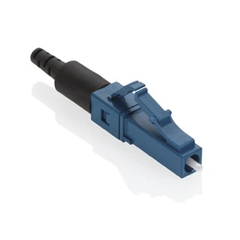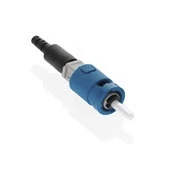Over the past decade, a lot has changed. The world slowly shifted from 3G to 4G with 5G on the horizon. People started consuming data more frequently, and the demand for quality content increased. Different industries are adopting the newer technology, and the demand for high data speed, wider bandwidth, and reliability started making copper cables redundant. People are slowly adopting fiber optic network cables as their preferred mode of data transmission.
Fiber optic cables can be used in a huge variety of applications, from small office LAN, to data centers, to inter-continental communication links. In fact, the trans-Atlantic internet runs primarily on underground fiber optic cables that are miles long. Unless you are an upcoming Internet Service Provider, you only need to worry about choosing the right fiber optic cable for your office or building network. Yet, based on the choices available and the different connector types, you can be lost in the rabbit hole searching for the right one even if opting for a pre-terminated fiber optic cable.
Differentiation based on Operation
Multimode Fibers
As the name suggests, the multimode fiber has multiple modes (or sources) of data travelling at the same time. The light travels through the core while being reflected multiple times. The standard wavelengths for multimode light source are 850nm and 1300nm. To accommodate the different light signals, the inner core diameter is 62.3µm or 50µm. There is further diversification in multimode fiber optic cables namely:- OM1
- OM2
- OM3
- OM4
- OM5
- OM6
The variation is majorly based on speed, bandwidth, and distance. Due to constant reflections, the propagation velocity for each signal changes and hence they reach the destination at different times. This leads to distortion which means signal loss. So multimode fiber cables cannot be longer than 500mtrs in most cases.
Single-mode Fibers
Single mode fiber only carries a single beam of precision laser, which travels in a straight line. So, the cable has a compartitively smaller inner diameter of < 9µm and the light source has to be between 1300 nm to 1550 nm wavelengths. Due to a straight beam being transmitted, it travels long distance before needing to be repeated. Unless the cable is bent beyond a threshold limit, the signal reaches the destination without any information loss.
Application Based Fibers
Indoor Cables
Indoor cables that are run across the interiors of the building. You may hide them inside overhead ducts, conduits, or bury it underground. These cables need to be flexible enough to run inside tight spaces but strong enough to bear crush weight and kinks. These fiber optic cables are double buffered and has a kevlar coating for reinforcement. By bundling together multiple cables, you can increase the strength for pulling and ruggedness purposes. They are suitable for conduit runs, riser and plenum applications, data centers and ideal for industrial applications.
Outdoor Cables
When you have cables running outside the building or in surveillance systems, it would be at the receiving end of harsh weather elements. You need to protect the cable from water ingress, vermin, direct sunlight and other conditions. You can opt for standard outdoor cables or go a step ahead with armored fiber optic cables. For places that may occasionally be flooded or have a threat of water penetration, you can opt for specialized gel within a loose tube that carries the main cable.
Type of Communications
1) Simplex Communications
Depending on the architecture of the cable, you can have one or two glass cores. Simplex fiber optic cable has a single core with single connector at the each ends.
2) Duplex Communications
In duplex communications, there is a pair of optical fibers that handles the two way communication. They may have individual connectors or a unified connector.
Connector Types
LC
The Lucent connector or LC type is a small form factor connector developed by Lucent Technologies. It is suitable for a ferrule size of 1.25mm and generally deployed in pairs for duplex communications.
 SC
SC
The Subscriber Connector was developed by NTT in Japan for fiber optic communications. It is used in duplex communication, which means two cables are paired inside a single connector. It is suitable for a ferrule size of 2.5mm.

ST
The Straight Tip connector is the AT&T’s response to SC connector. Also applicable for 2.5mm ferrule core, the ST connector implements push pull mechanism for quick insertion and removal. Similar to SC connectors these are also used for duplex connections.

MTRJ
The MTRJ connector closely resembles an RJ-style modular plug, even getting part of its name from the resemblance. It is an acronym for Mechanical Transfer-Registered Jack connectors and was developed by AMP/Tyco and Corning. It can also house two cables in a single connector, so is used for duplex communications.

Jacket Types
PVC (OFNR)
The most commonly used jacket for indoor optical fiber cable, the PVC jacket is cheap, durable, and easy to terminate. For office environment and data centers, cables with these jackets is generally used.
OFNP
The plenum jackets are much suited for cable running along overhead ducts. These are fire retardant and don’t emit smoke on burning. Most datacenters have a requirement for plenum cables.
LSZH
Low Smoke Zero Halogen is a cable material type that reduces the chances of toxicity when exposed to fire. Generally expensive compared to other jacket types.
PE
The polyethylene covering is built to be tough enough for outdoor weather and moisture. They are abrasion resistant. It is an affordable jacket choice for outdoor cables.
Jacket Colors
The major type jacket colors are:- Aqua
- Yellow
- OM1 and OM2 - Orange
- OM3 and OM4 - Aqua
- OM5 - Lime Green







